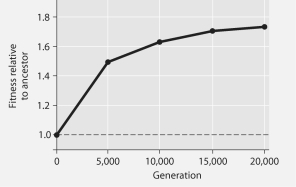Multiple Choice
The following questions refer to Figure 27.1 below, which is the same as Figure 27.10 in the textbook.
In this 8-year experiment, 12 populations of E. coli, each begun from a single cell, were grown in low-glucose conditions for 20,000 generations. Each culture was introduced to fresh growth medium every 24 hours. Occasionally, samples were removed from the populations, and their fitness in low-glucose conditions was tested against that of members sampled from the ancestral (common ancestor) E. coli population.

Figure 27.1
-Among the six statements below, which two best account for the results obtained by the researchers (see Figure 27.1) ?
1) Low-glucose conditions caused mutations that made individual E. coli cells better suited to these conditions.
2) Daughter cells acquired the ability to tolerate low-glucose conditions as they received the enzymes and membrane components that had been modified by their mother cell.
3) The initial E. coli population may have included some cells whose genes favored their survival in low-glucose conditions-OR-such genetic variants arose by chance early in the experiment.
4) The first few generations of E. coli in low-glucose conditions responded to the challenge by increasing the use of certain enzymes and ion pumps, while decreasing the use of others. This behavior was recorded in their gene sequences, which were later transmitted to daughter cells.
5) From generation to generation, there was an increase in the proportion of the experimental populations adapted to low-glucose conditions, because such bacteria produced relatively more offspring than did ancestral bacteria under low-glucose conditions.
6) During each generation, individual cells evolved to increase their survival in low-glucose conditions.
A) 3 and 5
B) 1 and 5
C) 2 and 4
D) 1 and 6
E) 1 and 3
Correct Answer:

Verified
Correct Answer:
Verified
Q59: Which statement about bacterial cell walls is
Q60: The following questions refer to structures found
Q61: Only certain prokaryotes can perform nitrogen fixation,
Q62: Figure 27.2 depicts changes to the amount
Q63: Which of the following statements is not
Q65: The following questions refer to structures found
Q66: Broad-spectrum antibiotics inhibit the growth of most
Q67: The following questions refer to structures found
Q68: Which of these is the most common
Q69: Match the numbered terms to the descriptions